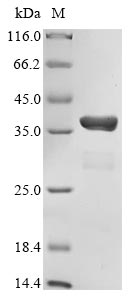Amino acids 1081-1197 form the expressed segment for recombinant Human CREBBP. This CREBBP protein is theoretically predicted to have a molecular weight of 40.7 kDa. This CREBBP recombinant protein is manufactured in e.coli. The CREBBP gene fragment has been modified by fusing the N-terminal GST tag, providing convenience in detecting and purifying the recombinant CREBBP protein during the following stages.
The human CREB-binding protein (CREBBP) is a versatile transcriptional coactivator that plays a pivotal role in gene regulation. CREBBP is involved in modulating various cellular processes by interacting with a wide range of transcription factors and nuclear receptors. It serves as a histone acetyltransferase, facilitating chromatin remodeling and promoting transcriptional activation. CREBBP is essential for embryonic development and has implications for cell growth, differentiation, and apoptosis. Dysregulation or mutations in CREBBP are associated with several genetic disorders, including Rubinstein-Taybi syndrome. Ongoing research focuses on unraveling the molecular mechanisms of CREBBP function, its involvement in disease pathways, and potential therapeutic interventions targeting its activity.






